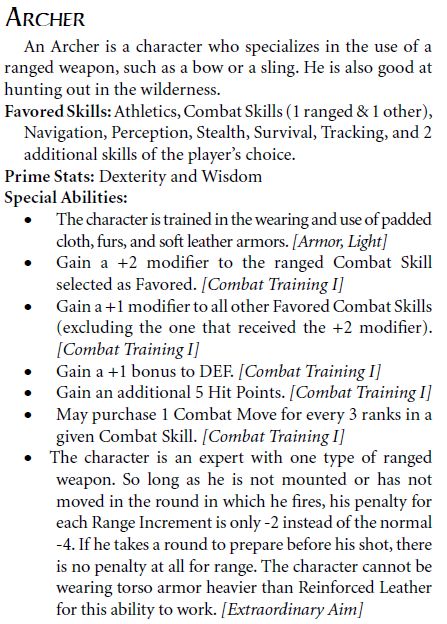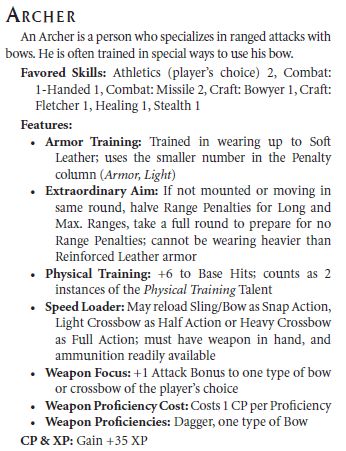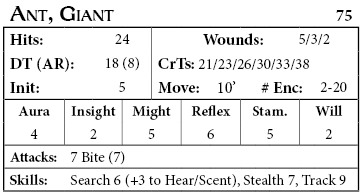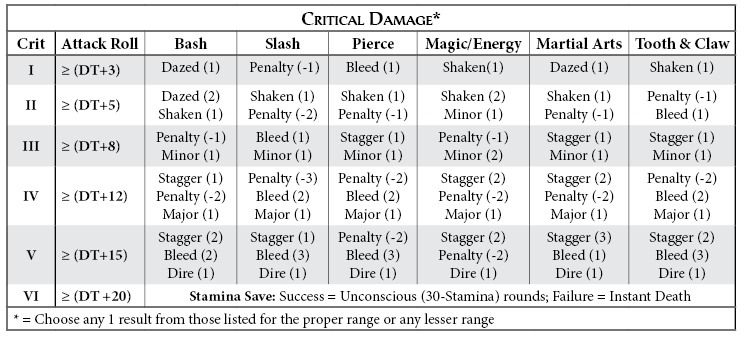Novus 2e Errata/FAQ
Click on any topic to open
Skills
It reads:
Spell Lore – The character may make a Magelore roll (TN 15 + the number of Spell Points used in the casting of the spell being identified) to identify a spell being cast by another spell user. This is required in order for a caster to be able to successfully counter a given spell.
It should read:
Spell Lore – The character may make a Magecraft roll (TN 15 + the number of Spell Points used in the casting of the spell being identified) to identify a spell being cast by another spell user. This is required in order for a caster to be able to successfully counter a given spell.
Equipment
The table for Weapons on page 42 lists the Damage Rating for the Sling as 4+Str.
The Damage Rating for the Sling should be 8, with no Strength Adjustments.
The table for Weapons on page 42 lists the Range Increment for the Spear as 50.
The Range Increment for the Spear should be 20.
Combat
This is a minor change to how Penalties work.
General Penalties apply ONLY to skill rolls, never to Secondary Stats (i.e. they would not apply to Saves or Defensive Threshold).
Penalties from Wounds apply ONLY to Secondary Stats, which means that they apply to Saves, Init, and DT.
Using this clarification, the two types of Penalties no longer overlap at all, and so both can apply at the same time.
Magic & Spells
General Magic Chapter Errata
In the right hand column, it explains that Casting Options can be chosen before casting or after casting. It needs to be clarified that when choosing Casting Options after casting, those options cannot alter the basic form of the spell. For example, you cannot change an Arc spell into a Bolt spell, or a Ball spell into a Cone spell after casting, only before doing so.
In the third paragraph of the left hand column, the last sentence of the paragraph reads:
So, using this option, the first target could be within 5’ of the caster, with the second one behind him at 10’ and a third one behind him at 15’, or it could be against 3 foes who are side by side with all of them standing 15’ from the caster.
It should read:
So, using this option, the first target could be within 5’ of the caster, with the second one behind the first foe at 10’ and a third one behind the second foe at 15’, or it could be against 3 foes who are side by side with all of them standing 15’ from the caster.
Universal Spell Errata
The Casting Option that says
Increase Clarity (removes Stun)
should read
Increase Clarity (removes Shaken)
Note: The cost of the casting option is not affected.
The Casting Option that says
Increase Effect* (Target Stunned)
should read
Increase Effect* (Target Shaken)
Note: The cost of the casting option is not affected.
Divine Spell Errata
The Spell costs says
(Mj 4/Mn 5/N 6)
should read
The Spell costs should be
(Mj 3/Mn 4/N 5)
The Casting Target Number (CTN) says
CTN: 26
should read
CTN: 19
The Fatigue cost says
Fatigue: 3
should read
Fatigue: 2
The Spell costs says
(Mj 3/Mn 4/N 5)
should read
The Spell costs should be
(Mj 2/Mn 3/N 4)
The Casting Target Number (CTN) says
CTN: 20
should read
CTN: 16
The Fatigue cost says
Fatigue: 2
should read
Fatigue: 1
The Casting Target Number (CTN) says
CTN: 20
should read
CTN: 16
High Magic Spell Errata
The Casting Target Number (CTN) says
CTN: 21
should read
CTN: 20
The Casting Target Number (CTN) says
CTN: 18
should read
CTN: 16
Mysticism Spell Errata
The Casting Option that says
Increase Duration (1 minute/rank)
should read
Increase Duration (5 minutes/rank)
Note: The cost of the casting option is not affected.
The Duration says
1 round/rank (C)
but it should say
5 minutes/rank (C)
The Casting Option that says Increase Duration (1 minute/rank) should be removed.
The Duration says 1 round/rank (C) but it should say 1 minute/rank (C)
The Casting Option that says
Increase Duration (1 minute/rank)
should be
Increase Duration (5 minutes/rank)
with no change in costs.
Monk Spell Errata
The Duration says 1 round/rank but it should say 1 minute/rank
The Casting Option that says
Increase Duration (1 minute/rank)
should be
Increase Duration (5 minutes/rank)
with no change in costs.
The Casting Target Number (CTN) says 24 but it should say 21
Ranger Spell Errata
The Casting Option, Increase Duration (1 minute/rank)
has a CTN of +4
it should have a CTN of +2
The Casting Option, Increase Duration (1 minute/rank)
has a Ftg of +2
it should have a Ftg of +1
The Duration says 1 round/rank but it should say 1 minute/rank
In the spell description, it says that attack deliver one extra round of Stunned. It should say one extra round of Shaken.
The Casting Option, Increase Area (per +5' radius)
has a CTN of +4
it should have a CTN of +1
The Duration says 1 round/rank but it should say 1 minute/rank
For those who are interested, here is a short overview of what can be found in the core rules.
| What is in the core book | |
| CP & XP |
CP stands for Character Points. These are spent in purchasing skills and other things for the character. As you spend your CP, they are converted to XP. XP is the total number of points spent on the character's development, and they give the overall measure of the character's development. Every character starts with 15 CP to spend. They can also gain CP (and XP) as they make their choices for their character. For example, the items listed below will tell if they give CP and/or XP, so a player's choices could result in more CP to spend. A starting character who has spent all CP will have a total of 100 XP. |
|
Races |
There are 8 in the Core Book
Races give the character modifiers to their Stats, and some special racial abilities. Kindred Talents These are purchasable talents/abilities, that players would use to create Half-Orcs, Half-Elves, or even Gnomes with just a touch of Dwarven blood in their veins. It is highly flexible allowing for any combination, but you are limited to no more than 2 different races beside the base race, if you want to be treated as that race for magical things. Now, these do require the player to spend CP to acquire them. |
| Cultures |
Novus 2e will contain 15 seperate Cultures to choose from. Each Culture provides skills to the character. The ones listed are generic, and GMs should definitely create Cultures that are unique to their setting as well. |
| Training Paths |
Novus 2e does not have Classes like many other games have. What we have is Training Paths. This is essentially the basic training that a character receives for the profession that they wish to follow. We have separated the Training Paths into 4 Categories/Classes that reflect the basic focus of the Training Path (these categories are only for making it easier to organize the Training Paths, they have absolutely no impact otherwise). Training Paths also give the characters ranks in skills, just like the Cultures do
Upon selecting a Training Path, the character gains 35 XP. At this point the character has 100 CP and XP combined. |
| Stats | Next up is the chapter for determining your character's stats. Each character has 8 stats, and then there what are called Secondary Stats. There are 7 of them and they are determined by adding together two of the base stats. You are given multiple options on how to determine those base stats. |
|
Background Options
|
Each race gives the character a number of background options that they can select to help individualize their character.
Background Options are divided into Gifts and Disadvantages. If a race gets 3 Background Options, the character may then choose 3 items from the Gifts section. However, some Gifts are more powerful than other and do require that you also select a Disadvantage as well. The GM has to approve the Disadvantage as a Disadvantage that does not actually impact the character is not a disadvantage. |
| Skills & Special Skills |
Novus 2e has a total of 27 skills. Many of these skills are what is called Base Skills, meaning that you use that skill's bonus for all applications of the skill. We also have skills that have Proficiencies. This means different applications of the skill use either a portion of that skill, or the full bonus, if they have a full proficiency in the different applications, as skill in one Proficiency often overlaps with other Proficiencies. And finally, we have Specialties. This is where the character has to purchase the skill seperately for each instance of the skill since there is no overlap in the different instances. Any skill gained from a Culture or Training Path is automatically considered Favored, which means it costs less to get each rank. The skills are also subject to diminishing returns, this means that the more ranks you have, the more that the skill costs per rank. These cost divisions happen after learning 10 and 20 ranks respectively. We then also have 14 Special Skills. These are learnable abilities, but usually are learned or acquired only once because once learned, they cannot be improved any more. |
| Other CP Cost Items |
There are a few other things that a player may spend CP on for his character. They are as follows:
|
| Running Novus |
This chapter gives rules and guidelines for the GM on how to use and adjudicate things in Novus. As Adventurers gain experience, they are awards Character Points. This chapter also explains how this works. |
| Creatures | This chapter covers how to determine if there is an encounter or not. It also provides 31 creatures that can be used for those encounters. |
| Treasures | This chapter contains guidelines on how much treasure a creature or foe might have, based on their total point value (their XP total) and provides a number of sample magical items that can be used as treasure. |
Currently, I am planning on releasing the Beta version of Novus 2nd Edition by the end of April, 2019. Read on for a bit more information on what it will look like! I will only include a few tidbits this time, and then add more later on.
Levels
Novus 2nd Edition will no longer contain levels at all. Instead, your characters will have a point value that is comprised of your unspent Character Points (CP), and your Experience Points (XP).
Experience Points are basically Character Points that you have spent on things like skills, talents, spells, combat styles, etc.
Classes & Training Paths
Classes are another thing that are being dropped. This time in favor of what I call Training Paths. In Novus 1st Edition, a Class provided a character with a list of Favored Skills, but no ranks in them.
In Novus 2nd Edition, the Training Path grants ranks in specific skills (as does Backgrounds and Cultures), and any skills gained in this manner are automatically Favored. Training Paths also give the character a number of XP (or in some cases, both CP and XP -- Backgrounds and Cultures can do this as well).
 Archer from Novus 1st Edition |
 Archer from Novus 2nd Edition |
As you can see from the above images, there are a number of differences between the two.
One of the changes in the next version of the Beta is the introduction of a critical system. This is an extension of the Secondary Damage guidelines in the previous versions of the Beta. Read on for more details....
The following image shows the upcoming Critical Table.
As you can see, there are 6 levels of criticals, and many of the levels have multiple entries. However, if you deliver a critical, you only select one of those effects. The effect selected is up to the player delivering the attack. However, they are not limited to just what is allowed for that critical level and type.
They may, should they like, choose any one lesser effect from the same column.
Example: Your attack delivers a Slash IV critical. This means that you can choose to deliver a -3 Penalty, 2 Hits of Bleeding damage or a 1 Major Wound. You may also, if you do not want to be quite as deadly, select a Minor Wound, 1 Hit of Bleeding, a -2 Penalty, 1 round of Stun (Shaken), or a -1 Penalty.
Yes, it appears that there would be a lot of math involved to determine whether or not a critical might be delivered. However, this math only need be done once for Player Characters, as there is a space on the character sheet for recording this information.
For monsters, this information is provided as part of the standard stat block.

The abbreviation "CrTs" stands for Critical Thresholds, but I love that you can also sound it out as if saying crits.There are 6 entries just as there are six levels of criticals.
In Novus 1E, we simply had hit points. Different races had different maximums amounts of hits. I had also been fascinated by a couple of systems that used a 2 level type hits system, whether they called them wounds or life points, or something else. So, I wanted to go in a slightly different direction, and here was what I came up with.
Novus 1E
In Novus 1E, hits were 20+Str+Con+Special, and you could then gain hits until you got to Racial Max+Str+Con. This was okay, but it could still lead to a lot of hits.
Novus 2E
In Novus 2E, you have Hits (sometimes referred to as Fatigue), and Wounds. Instead of Spell Points, Novus 2E uses Fatigue (i.e. hits) to power spells.
Each race has a number of Base Hits. To this, the character adds their Stamina (a Secondary Stat), and the bonus hits from Training Path Abilities or Talents purchased.
When a character reaches zero hits, he is unconscious.
Every character also has a number of Wounds that he can take, and they are divided into Minor, Major, & Dire. Each Minor Would would apply a -1 to actions, a Major Wound would apply a -2, and each Dire Wound applies a -3 modifier.
The 3 different types of wounds can be acquired separately. You can receive a Dire Wound without first getting a Minor or major Wound.
Once you receive a penalty of -10 or higher, you must make a Stamina Save to stay conscious for 1 minute for each point that the Save is failed by. If the penalty is -20 or higher, he is unconscious without a Save until the Penalty drops below -10.
You can take a number of Minor Wounds equal to your Constitution. You can take a number of Major Wounds equal to your Constitution minus 1, and you can take a number of Dire Wounds equal to your Constitution minus 2. You can never had less than 1 of each type of Wound. So, even if you had a Constitution of zero, you would have have at least one of each type of Wound. (Note: I am currently considering altering this to allow for more Wounds overall)
Secondary Damage
There are several types of Secondary damage that you can receive as well. Each type of attack can do up to 2 types of Secondary Damage. And the thresholds for taking Secondary Damage is based on the number of hits you take (after adjustments for armor). Con+2 in hits results in Type I Secondary Damage, and Stamina+2 in hits
There are 3 types of Stuns (Dazed, Sunned, & Staggered). These do not give you any penalties. Instead, they limit how many Actions you can perform during a round. .
There are also Penalties (gained from things other than Wounds, but still totaled with them), and Bleeding. Bleeding is basically continuing damage. Each point of Bleeding reduces hits 1 per round until all hits are gone, and then Minor Wounds, then Major Wounds and finally Dire Wounds.
Secondary Damage is applied based on how much damage you take in Hits, or from the use of Boon Points (which are still earned in the same manner).
Healing
Fatigue/Hits fully heals after 4 hours of rest/sleep.
Minor Wounds take 1 full day of rest to heals each point. Major Wounds require 1 full week of rest to heal, and Dire Wounds require 2 full weeks of rest to heal each point.
Penalties from Wounds heal as the Wounds heal. Penalties from other sources are treated as Minor Wounds for how long it takes them to heal
Bleeding must first be stopped before it will heal. Once stopped, it take 1 full day of rest to fully heal each point of bleeding. Strenuous activity before Bleeding is fully healed can re-open it and cause Bleeding to resume.



